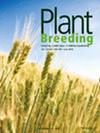黄瓜(Cucumis sativus L.)白色未成熟果皮颜色基因 w 的 dCAPS 标记的开发与应用
IF 1.8
4区 农林科学
Q2 AGRONOMY
引用次数: 0
摘要
未成熟果皮颜色是影响消费者选择的一个关键因素,也是黄瓜的一个重要外部品质性状。应用分子标记辅助选择(MAS)可显著提高以果皮颜色为重点的黄瓜育种过程的效率。在本研究中,我们根据黄瓜白色未成熟果皮调控基因w(Csaprr2)的1-bp'G/-'序列插入,开发了一个与黄瓜白色未成熟果皮调控基因w共分离的dCAPS标记Csw_dCAPS。在 59 个黄瓜商业栽培品种和 41 个近交系中对 Csw_dCAPS 标记进行的两次验证表明,Csw_dCAPS 标记在识别等位基因 W 和 w 控制的绿色和白色未成熟果皮方面具有 100% 的准确率。在黄瓜品系 XNS023-1 和 XNS023-2 中应用 Csw_dCAPS 标记发现,XNS023-1 中的白色未成熟果皮也是由基因 w 的 1-bp 'G/-' 插入引起的。此外,我们还将这一新开发的标记与之前报道的连锁标记 SSR06791 进行了比较,以强调 Csw_dCAPS 的精确性和可靠性。本文首次报道并验证了与白色未成熟果皮调控基因w完全共分离的dCAPS标记Csw_dCAPS。本文章由计算机程序翻译,如有差异,请以英文原文为准。
Development and application of a dCAPS marker for the white immature fruit rind colour gene w in cucumber (Cucumis sativus L.)
Immature fruit rind colour, a key factor influencing consumer choice, is an important external quality trait in cucumbers. The application of molecular marker‐assisted selection (MAS) can significantly improve the efficiency of the cucumber breeding process that focuses on fruit rind colours. In this study, we developed a dCAPS marker Csw_dCAPS co‐segregated with cucumber white immature fruit rind regulating gene w (Csaprr2 ) based on its 1‐bp ‘G/‐’ sequence insertion. Both validations of marker Csw_dCAPS among 59 cucumber commercial cultivars and 41 inbred lines showed that the Csw_dCAPS marker has 100% accuracy rates in identifying the green and white coloured immature fruit rinds controlling by alleles W and w . Application of Csw_dCAPS marker in cucumber lines XNS023‐1 and XNS023‐2 revealed that the white immature fruit rind in XNS023‐1 is also caused by the 1‐bp ‘G/‐’ insertion of gene w . We discussed the derivation of gene w in cucumber XNS023‐1 according to the genetic background differences between XNS023‐1 and XNS023‐2. Besides, this newly developed marker was also compared with the previously reported linkage marker SSR06791 to underscore the precision and reliability of Csw_dCAPS. Herein, we first reported and verified a dCAPS marker Csw_dCAPS that completely co‐segregated with the white immature fruit rind regulating gene w . We concluded that this high‐accuracy dCAPS marker can effectively facilitate the MAS breeding process of new cucumber cultivars characterized by white‐coloured immature fruits.
求助全文
通过发布文献求助,成功后即可免费获取论文全文。
去求助
来源期刊

Plant Breeding
农林科学-农艺学
CiteScore
4.40
自引率
5.00%
发文量
74
审稿时长
3.0 months
期刊介绍:
PLANT BREEDING publishes full-length original manuscripts and review articles on all aspects of plant improvement, breeding methodologies, and genetics to include qualitative and quantitative inheritance and genomics of major crop species. PLANT BREEDING provides readers with cutting-edge information on use of molecular techniques and genomics as they relate to improving gain from selection. Since its subject matter embraces all aspects of crop improvement, its content is sought after by both industry and academia. Fields of interest: Genetics of cultivated plants as well as research in practical plant breeding.
 求助内容:
求助内容: 应助结果提醒方式:
应助结果提醒方式:


